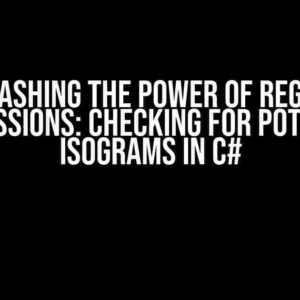Are you tired of manually searching for specific commit hashes in your Git repository’s log? Do you want to automate the process of extracting hash values from the Git log output? Look no further! In this article, we’ll show you how to capture hash values from `git log –oneline –graph` using regular expressions (regex).
What is Git Log –oneline –graph?
The `git log –oneline –graph` command is a powerful tool for displaying a concise and visual representation of your Git repository’s commit history. The `–oneline` option condenses each commit to a single line, while the `–graph` option adds an ASCII art graph to the output, making it easier to visualize the commit relationships.
$ git log --oneline --graph * 2345678 (HEAD -> main) Commit message 3 | * 3456789 Commit message 2 |/ * 1234567 Commit message 1
Why Capture Hash Values?
Capturing hash values from the Git log output can be useful in various scenarios, such as:
- Automating tasks, like creating changelogs or updating version numbers.
- Generating reports or summaries of changes.
- Integrating with other tools or scripts that require commit hashes as input.
Regex to the Rescue!
Regular expressions (regex) provide a powerful way to extract specific patterns from text data. In this case, we’ll use regex to capture the commit hash values from the `git log –oneline –graph` output.
Understanding the Regex Pattern
The regex pattern we’ll use is: `\* ([a-f0-9]+) .*`
Let’s break it down:
- `\* `: Matches the asterisk (`*`) character, which is used to indicate the start of a commit line.
- `([a-f0-9]+)`: Captures one or more hexadecimal characters (commit hash) using a capturing group (`(` `)`).
- ` .*`: Matches any remaining characters on the line (commit message, etc.).
Capturing Hash Values
To capture the hash values, we’ll use the `git log` command with the `–oneline –graph` options, and pipe the output to a regex tool, such as `grep` or `perl`.
Using Grep
$ git log --oneline --graph | grep -oP '\* \K[a-f0-9]+' 2345678 3456789 1234567
In this example, we use `grep` with the `-o` option to print only the matched text (i.e., the commit hash) and the `-P` option to enable Perl-compatible regex.
Using Perl
$ git log --oneline --graph | perl -nle 'print $1 if /\* ([a-f0-9]+)/' 2345678 3456789 1234567
In this example, we use `perl` with the `-n` option to process the input line-by-line and the `-l` option to automatically append a newline character to each printed line. The `print $1` statement outputs the captured group (commit hash).
Real-World Scenarios
Now that we’ve learned how to capture hash values, let’s explore some real-world scenarios where this technique can be applied:
Automating Changelog Generation
| Commit Hash | Commit Message |
|---|---|
| 2345678 | Commit message 3 |
| 3456789 | Commit message 2 |
| 1234567 | Commit message 1 |
By capturing hash values and corresponding commit messages, we can generate a changelog like the one above.
Updating Version Numbers
$ git log --oneline --graph | grep -oP '\* \K[a-f0-9]+' | xargs -I {} sh -c 'echo "Version: {}" >> version.txt'
In this example, we capture the hash values and use `xargs` to append each value to a file named `version.txt`.
Conclusion
In this article, we’ve demonstrated how to capture hash values from `git log –oneline –graph` using regex. By leveraging the power of regex, you can automate tasks, generate reports, and integrate with other tools and scripts. Remember to adapt the regex pattern and commands to fit your specific use case.
So, the next time you need to extract commit hashes from the Git log, don’t hesitate to use regex to simplify the process!
Frequently Asked Question
Get ready to unlock the secrets of capturing hash values from Git log outputs using regex!
What is the purpose of using `git log –oneline –graph` and how does it relate to capturing hash values?
The `git log –oneline –graph` command is used to display a condensed version of the commit history in a graphical format, showing the commit hashes, authors, and messages. By using regex, we can extract the hash values from this output, allowing us to further process or analyze them. It’s like finding a needle in a haystack, but the haystack is a beautiful, graphical representation of your commit history!
What is the regex pattern to capture the hash values from `git log –oneline –graph` output?
The regex pattern to capture the hash values is `\b[0-9a-f]{7,40}\b`. This pattern matches hexadecimal strings of 7 to 40 characters, which is the typical format of Git commit hashes. The `\b` characters ensure that we’re matching whole words only, avoiding partial matches within other strings.
How can I use `git log –oneline –graph` and regex to extract hash values in a Unix-like environment?
You can use the following command to extract the hash values: `git log –oneline –graph | grep -oE ‘\b[0-9a-f]{7,40}\b’`. This command pipes the output of `git log –oneline –graph` to `grep`, which uses the regex pattern to extract the hash values.
Can I use `git log –oneline –graph` and regex to extract hash values in a Windows environment?
Yes, you can use the following command in a Windows environment: `git log –oneline –graph | findstr /r “\b[0-9a-f]{7,40}\b”`. This command uses the `findstr` command, which is the Windows equivalent of `grep`, to extract the hash values using the same regex pattern.
What are some potential use cases for capturing hash values from `git log –oneline –graph` output?
Captured hash values can be used for various purposes, such as creating scripts to automate tasks, generating reports, or even creating visualizations of your commit history. You can also use them to identify specific commits, create custom Git hooks, or integrate with other development tools.


